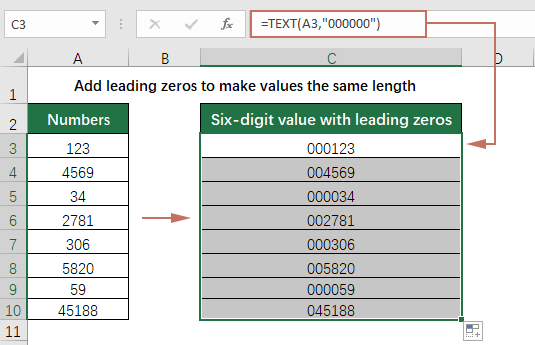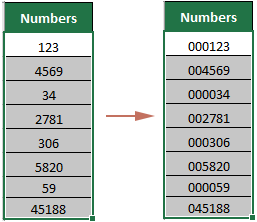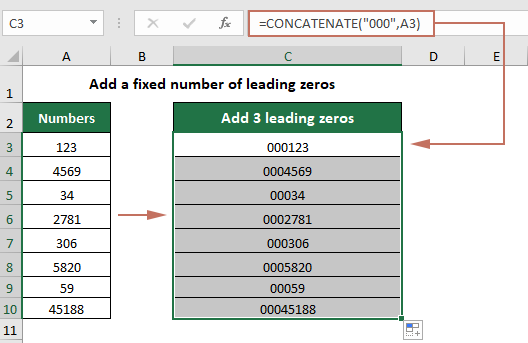Add Leading Zeros in Excel: Make Values the Same Length or Add Fixed Zeros
Adding leading zeros in Excel is a practical requirement in many data processing scenarios. Whether you need your values to meet specific length standards—such as for product codes, invoice numbers, employee IDs, or system import constraints—or simply want all your data to appear uniform, there is often a need to insert zeros at the beginning of numbers or text. In Excel, if you attempt to manually type a zero in front of a number, the application will automatically remove it, since leading zeros are generally not shown in numerical fields. This can cause issues for users who need such formatting for database systems, printing, or to comply with external regulations.
This tutorial introduces a range of practical solutions, including Excel’s built-in formulas and formatting tools, as well as third-party add-ins like Kutools for Excel. Both common situations are covered: how to make all values the same length by padding leading zeros, and how to add a fixed number of zeros regardless of original value length. The chosen solution often depends on data type (numbers or text), whether calculations are needed afterward, and the scale of your dataset.


- Use the TEXT function to pad numbers with leading zeros
- Use the format cells feature to pad numbers with leading zeros
- Use the CONCATENATE function to add a fixed number of zeros
- Easily Add Leading Zeros Using Kutools for Excel
Add leading zeros to make numbers the same length
Standardizing the length of identifiers or codes—such as account numbers, order IDs, or license numbers—is a frequent data processing need. For example, an organization may require all product codes to be six digits, meaning values like 23 must display as 000023. To avoid manual editing, Excel offers efficient tools to pad numbers with leading zeros, either by calculation or display.
These methods work best when:
- Your source values are numerical and you want to keep them suitable for calculations.
- You need a consistent appearance for import/export tasks or forms.
- Processing relatively small to medium-sized datasets manually, or updating templates frequently.
- Formulas like TEXT convert numbers to text, which may not suit all downstream calculations.
- Cell formatting affects only display, not the actual stored value.
Use the TEXT function to pad numbers with leading zeros
The TEXT function provides a simple, reliable way to format numbers as text with a specified length, automatically filling in the appropriate number of leading zeros. This is ideal for generating printable reports, importing files, or any scenario where appearance and string length consistency are priorities.
Suppose you have a list of numbers in column A (for example, A1:A10) and need to display them all as six-digit codes (e.g.,000231 or 000007). You can achieve this using a formula in the adjacent column.
1. Enter this formula in a blank cell (for instance, B1):
=TEXT(A3, "000000")2. After typing the formula, press Enter. To process the entire column, use the fill handle to drag the formula down as far as needed. This ensures each number is represented as a six-digit string, with zeros added at the beginning as appropriate.

Use the format cells feature to pad numbers with leading zeros
If it's important to preserve the original numeric nature of your data for sorting or mathematical operations, Excel’s Format Cells feature can display numbers with leading zeros while keeping their underlying values unchanged. This method is suitable for on-screen viewing, printing, and exporting reports—especially where systems will read or display the data as entered.
- Select the range of cells containing the numbers you want to format uniformly.
- Right-click and choose "Format Cells" to open the "Format Cells" dialog box. Tip: For quick access, you can also press Ctrl +1.
- Navigate to the "Number" tab, select "Custom" from the "Category" list, then input your desired format in the "Type" field. For example, to make all numbers six digits, type 000000 (as many zeros as needed for your preferred length).
- Click "OK" to confirm.

The targeted numbers now appear with leading zeros in your worksheet. Be aware, however, that Excel still treats these as values without the leading zeros in the actual cell content. This means copying these cells to another program or worksheet may strip the formatting—consider using formulas or converting the results to values if you intend to export or share the data.

Add a fixed number of leading zeros to numbers or text
In certain workflows, rather than ensuring a standard length, you might need to prepend a set quantity of zeros for system compatibility, barcode generation, cataloging, or to visually distinguish data. Unlike length-based padding, this approach adds zeros regardless of the length of the original value or whether the source is a number or a text string.
This is often useful in:
- Creating data import files for systems that recognize specific prefixes.
- Ensuring codes or ID sequences are visually distinct for human reading.
- Standardizing the appearance of both numerals and text strings in a mix of data.
Use the CONCATENATE function to add a fixed number of zeros
The CONCATENATE function (or the ampersand, & operator) offers a direct method to attach a predefined number of zeros at the start of any cell value, whether numeral or text. This is especially handy when you need to apply a uniform prefix or convert data for system readiness.
Suppose your data range is A3:A10 and you want to add three leading zeros to each value:
1. Enter this formula in the adjacent cell, such as C3:
=CONCATENATE("000", A3)2. Press Enter, then use the fill handle to copy the formula down alongside all your source values. Every value, regardless of its length or data type, will now begin with three zeros in the results column.

- The result is in text format, meaning numerical operations may not behave the same as with numbers unless converted back.
- This method also works for cells containing text, not just pure numbers.
- If you wish to change the number of zeros, simply adjust the number of zeros inside the formula accordingly.
Easily Add Leading Zeros Using Kutools for Excel
When working with larger tables or repetitive batch tasks, using Excel’s built-in methods may become time-consuming. Kutools for Excel provides an intuitive interface for batch-inserting leading zeros or other text to the beginning of multiple cells at once, without needing any formulas. This is particularly valuable when processing large datasets or when you want a point-and-click solution.
After installing Kutools for Excel, you can proceed as follows:
- Select all the cells where you want to add leading zeros.
- Go to the "Kutools" tab, choose "Text", and then click "Add Text".
- In the "Add Text" window, enter the specific number of zeros you want in the "Text" field. To ensure the zeros are added as characters, start with an apostrophe (for example, typing '0000 will add four zeros).
- Select "Before first character" as the position option to insert the zeros at the start of each value.
- Click "OK" to complete the process.

All selected cells will now visibly start with the specified zeros. Kutools’ batch capabilities simplify adding or removing leading characters across multiple rows or columns with only a few clicks, making it ideal for regular spreadsheet maintenance or whenever you want to streamline handling cell content formatting.
You can also use the Add Text tool to insert characters elsewhere (for example, at the end of cells or at a specific position), making it versatile for more complex formatting needs.
Kutools for Excel - Supercharge Excel with over 300 essential tools, making your work faster and easier, and take advantage of AI features for smarter data processing and productivity. Get It Now
Demo: Add leading zeros to numbers or text with Kutools for Excel
Best Office Productivity Tools
Supercharge Your Excel Skills with Kutools for Excel, and Experience Efficiency Like Never Before. Kutools for Excel Offers Over 300 Advanced Features to Boost Productivity and Save Time. Click Here to Get The Feature You Need The Most...
Office Tab Brings Tabbed interface to Office, and Make Your Work Much Easier
- Enable tabbed editing and reading in Word, Excel, PowerPoint, Publisher, Access, Visio and Project.
- Open and create multiple documents in new tabs of the same window, rather than in new windows.
- Increases your productivity by 50%, and reduces hundreds of mouse clicks for you every day!
All Kutools add-ins. One installer
Kutools for Office suite bundles add-ins for Excel, Word, Outlook & PowerPoint plus Office Tab Pro, which is ideal for teams working across Office apps.
- All-in-one suite — Excel, Word, Outlook & PowerPoint add-ins + Office Tab Pro
- One installer, one license — set up in minutes (MSI-ready)
- Works better together — streamlined productivity across Office apps
- 30-day full-featured trial — no registration, no credit card
- Best value — save vs buying individual add-in

